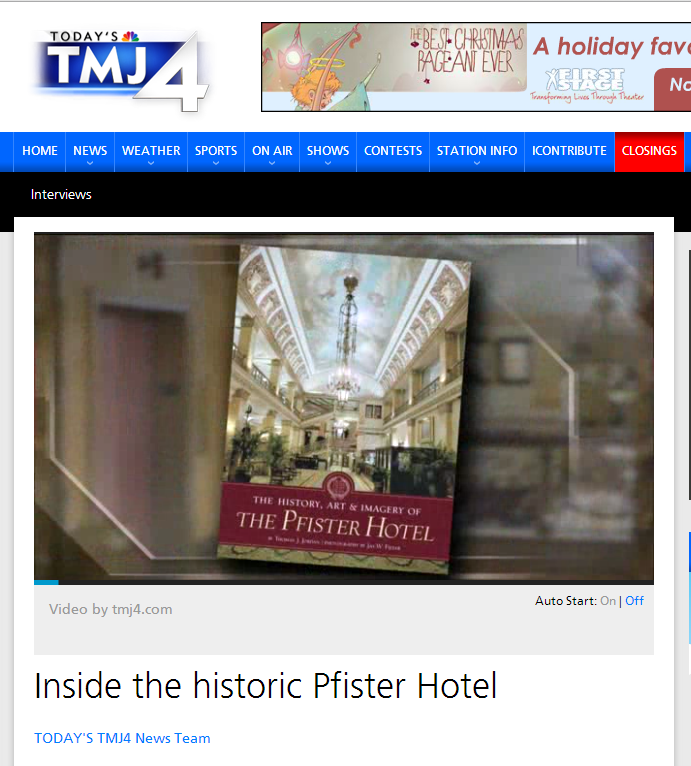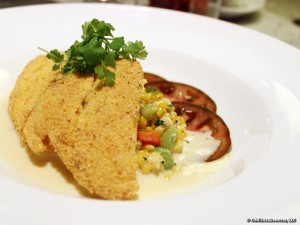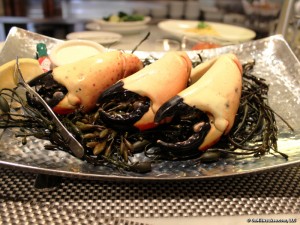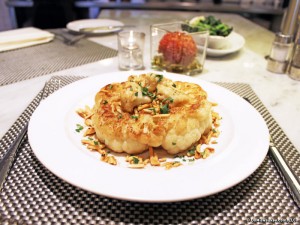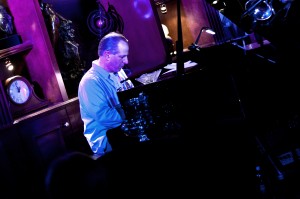Marcus Hotels Press > Press Coverage
12.20.13 |
Today’s TMJ4: Inside the Historic Pfister HotelDecember 19, 2013 | Today’s TMJ4 The historic Pfister Hotel is celebrating its 120th anniversary, and TODAY’S TMJ4 was invited for a look inside like never before. A new book is out filled with amazing photographs that tell the history of the hotel. The hotel’s general manager, Paul Ohm, joined Live at Noon to discuss it. Click here to view the clip from Today’s TMJ4 Live at Noon: http://www.jrn.com/tmj4/on-air/interviews/Inside-the-historic–236597551.html
|
12.12.13 |
Fox 6 Wakeup: Pfister Hotel gets new book in honor of 120th anniversaryDecember 12, 2013 | Fox 6 Wakeup The historic Pfister Hotel is celebrating 120 years — and in honor of the big anniversary — there’s a brand new book. Paul Ohm, the general mananger at the Pfister, joins FOX6 WakeUp with all the details. Click here to view the clip from Fox 6 Wakeup: http://fox6now.com/2013/12/12/pfister-hotel-gets-new-book-in-honor-of-120th-anniversary/  |
12.04.13 |
OnMilwaukee.com: Mason Street Grill menu inspired by travels to the SoutheastNovember 29, 2013 | Lori Fredrich – Special to OnMilwaukee.com | Photography by Paul Fredrich What goes into planning new menus at area restaurants? Often, it’s a matter of taking inspiration from locally produced ingredients to put together a seasonal menu. But, sometimes it takes a trip to a new place to reinvigorate a chef’s palate and instigate the creation of something entirely new and different. Such is the case at Mason Street Grill, whose recently launched autumn and winter menu features a plethora of delicious plates with a Southeastern flair inspired by Chef Mark Weber and General Manager Edward Carrella’s recent trip to Georgia and South Carolina. Dishes like roasted blackened swordfish with preserved lemon, brown butter, capers and spinach, and cornmeal crusted Floridian snapper served with cream lady pea succotash not only provide a mental escape to warmer climes, but they also embody the thought process that happens when chefs travel to various parts of the world to gain inspiration for their next best dishes. Weber says that the restaurants they visited were determined primarily through referrals from other chefs. So, they stayed away from tourist spots and chain restaurants and really focused on chef-driven menu concepts. “Before we go on a trip, we already have a lot of ideas in mind of what we want to change about the menu, but we don’t always know how we are going to make the changes,” says Weber. “We definitely go armed with a lot of questions in mind. As you begin to experience the food and flavors, your mind starts moving and you begin to fill in the holes.” Once the chef returns to Milwaukee, it’s a matter of moving on to the experimentation phase to see which takeaways make sense for a new menu, and which don’t. “We always want to tell a story in our menu,” Weber goes on. “So we start with a very high level story line and get more specific with each dish.” In this case, Weber says they were primarily looking for inspiration for new accompaniments for signature dishes. “We weren’t looking for diversity in meats or proteins necessarily, rather in sides, seasoning and ingredients,” says Weber. “The spiciness in cuisines in both South Carolina and Georgia was far more intense than what we taste locally. They incorporated a lot of different ingredients into dishes, such as okra, corn meal and kale.” One of the things he says they look for as they travel is a sense of the culinary trends happening in different places. “We found it very interesting that a lot of the restaurants we visited had many similarities in terms of menu items and culinary trends,” he says. “We expected to see a larger variety of different foods, but in reality, many of them shared similar food and menu choices.” It’s something you wouldn’t know unless you actually traveled to that place, he underscores. “We can read all we want about regional food trends, but when you actually get to taste it firsthand, you can truly experience a city or region’s culinary flavor and mark,” he explains. “An example is with tender octopus in Atlanta. Who would equate octopus to being a standout dish in Atlanta? We went to a few different restaurants that all had tender octopus on the menu. If you pay attention from restaurant to restaurant, you can learn what’s going on in a city from a culinary standpoint and the certain players starting these trends.” The trends a chef experiences on a trip can heavily influence how recipes develop for a new menu, as well as the type of offerings. Weber reports an increase in the “non-center-of-the-plate” approach to dining in the restaurants that they visited. In other words, the focus of the menus wasn’t so much on expensive steaks or fish, but instead on accompaniments and seasonings. This trend is reflected in creative new side dishes on the fall and winter menu, like roasted cauliflower, autumn root vegetable hash and Tuscan kale and cabbage. When I asked if they had favorite spots they visited along the way, Weber was quick to respond. “We liked South Carolina a lot,” he says. “It seemed that everyone in the restaurant scene knew each other. We were surprised about the caliber of restaurants in Charleston, since it’s such a small city. “The Optimist in Atlanta also impressed us on the quality of food and preparations. There wasn’t a flaw in the restaurant. Menu, service and execution were completely on point, and the space had great history that was nicely incorporated into the décor and overall feel.” In addition to dishes like seafood gumbo featuring fresh seafood, okra and white rice, which appears on both the lunch and dinner menus, diners will also find dinner items like herb crumb crusted Chilean sea bass with roasted pepper sauce and pickled jalapeno relish as well as Florida Stone Crab claws, which are a limited edition seasonal item. “We are bringing them in as fast and furious as we can get them, but the stone crab season has been relatively light this year.” Weber says. “We are committed to serving only the best, freshest crab, while some competitors may resort to lesser quality or frozen if the season isn’t prime.” Weber says that the stone crab season is highly dependent upon water temperatures and weather conditions. In fact, the worse the weather is, the better the crab season tends to be. “The weather has been pretty nice,” he says. “And we have no idea how the rest of the season will pan out … so come in and get them while you can!” Crab claws run from $25.95 for two 3-5-ounce claws up to $130.95 for eight 5-8-ounce claws. Diners can also choose the combination seafood platter for $45, which includes four oysters, four shrimp and two stone crab claws. For a look at the new menu visit masonstreetgrill.com. |
11.07.13 |
All Kinds of NewOriginal Article by Jeanette Hurt for Milwaukee’s Lifestyle Magazine Slice ‘N Dice If you’ve ever enjoyed chef Kos Saeng’s signature sushi rolls at Screaming Tuna in the Third Ward or Yokosa in Brookfield, you’ll want to check out his latest restaurant venture, Slice ‘N Dice in Pewaukee. “We decided to branch out west because we have family out here,” Saeng says. You can’t go wrong with any of Saeng’s superb sushi rolls, but the Signature Slice roll is my favorite. It consists of shrimp, crab, tuna and a mix of eel sauce and spicy lava sauce. Another good choice is the Korean filet mignon. Saeng marinates the bone-in steak in a homemade marinade — all of his sauces are made from scratch. It tastes like a cross between filet and Korean short ribs. On the seafood side, Saeng does an Asian interpretation of the classical fettuccine Alfredo. He uses Japanese udon noodles, adds a bit of yuzu (citrus) sauce to the cream and tops the dish with scallops, shrimp and veggies. Saeng is planning to add spiced apple cider drinks and a Thanksgiving roll or two to the November menu. “I always like to do things a little differently,” he says. “For example, I like to add bacon to some of my rolls. I’ll also do some holiday-themed rolls for Christmas, but with a twist.” www.facebook.com/SliceDiceSushi Cafe La Paloma HOM The Rodgers partnership with SURG continues (SURG severed ties with Braun earlier this year). “We didn’t want Aaron behind just one individual concept, and it’s much better for him to be involved in our overall plan,” Shaikh says. www.homwoodfiredgrill.com Kil@wat A seared diver scallop and pork belly appetizer is accompanied by a cucumber salad and a mango-lemongrass coulis. The roasted beet salad comes with a caramelized shallot and honey dressing, and is topped with house-made ricotta. Druschitz and his culinary team also have focused on increasing the speed and efficiency of dining for its theater-going guests. “We’ve re-evaluated some of our processes to ensure that we can serve our theater diners an unforgettable meal while keeping in mind their full schedules,” Druschitz says. www.kilawatcuisine.com |
11.01.13 |
Documentary Explores Luxury, History of Iconic Pfister HotelOriginal Article by Eleanor Peterson and Mark Siegrist for WUWM.com
Though the number of hotels and hotel rooms in downtown Milwaukee is growing, one hotel has remained front and center. The Pfister Hotel endures as the city’s iconic hotel, despite a new Marriott, a Hilton Garden Inn, and Fairfield all having opened nearby. The 120-year-old luxury hotel, which is only a stone’s throw from the lakefront on Wisconsin Avenue, is the focus of a half-hour behind-the-scenes documentary premiering on Milwaukee Public Television on October 31st. Host and producer Mark Siegrist says he was inspired to create Inside the Pfister: A Milwaukee Hotel Icon while covering stories for Channel 12. “It’s Milwaukee at its finest,” Siegrist says. “The whole concept back at the turn of the century was to build the Pfister Hotel as a gateway to Milwaukee. And at the same time, Milwaukeeans are very, very welcome in its lobby.” The Pfister replaced as the city’s premiere hotel the Newhall House, which was destroyed in a tragic fire in 1883 that killed 90 people. Milwaukee’s civic leadership immediately began plans to replace the Newhall House because they needed a place to show off the relatively new city. Guido Pfister fronted the money and ten years after the Newhall fire, the building was completed. Pfister passed away during construction, but his children, Charles and Louise, carried out his plans to the end. In 1962, the hotel was facing the wrecking ball when it was saved by Ben Marcus, who acquired the building to restore its original beauty. Since its salvation and restoration, the Pfister has gained an international reputation for being a high-quality meeting place and a flagship and center for hospitality.
|
10.24.13 |
Huffington Post: Museum Lovers Guide to MilwaukeeOctober 23, 2013 | Huffington Post The Pfister Hotel’s Artist-in-Residence program was highlighted in a Huffington Post article featuring Milwaukee’s museum scene. Read on to learn about how The Pfister not only houses art of the past, but also supports contemporary artists of today. Milwaukee is more than cheese. Everyone knows that Milwaukee brought us Happy Days,Laverne and Shirley, countless breweries and cheeseheads. It’s true, we love our tailgating culture, but Milwaukee also has world class museums, and not just your garden-variety art galleries. The barons of this proud industrial town funneled a large portion of their fortunes into “The Arts.” Milwaukee has a long history of supporting and appreciating their artists. When Santiago Calatrava created the internationally acclaimed Quadracci Pavilion and Reiman Bridge to the Milwaukee Art Museum, he exposed our secret: Milwaukee is a city full of art aficionados! Harley Davidson Museum (Photo credit: Jessica Reid) Spending the day at the Harley Davidson Museum will thrill the most jaded, leather-clad biker. But besides the coolness factor, you will be surprised by how much you will learn! From the story of three friends who started building bikes in 1903 to the brand’s role in pop culture, the Great Depression and World War II, the museum is fascinating. A new exhibitpays tribute to the 15,000 people who died during the tragic 2011 tsunami. It features the remains of a bike that travelled 4,000 miles from Japan to a beach in British Columbia. The museum also has an excellent cafe and restaurant with more memorabilia and motorcycle parts adorning the walls and tables. All this and one of the best (albeit expensive) museum gift shops in the world. Pabst Mansion (Photo credit: Pabst Mansion) Let’s say you love architecture and your date loves beer. Why not compromise and spend the day touring the Pabst Mansion followed by a picnic with some cans of PBR? This would make beer baron Captain Frederick Pabst a very happy man. The Captain’s home is the only Gilded Age mansion left on Milwaukee’s Grand Avenue. If you can’t get enough beer, you might also consider sleeping at the new Brewhouse Inn and Suites, a Neo-Victorian 90 room hotel built around the original brew kettles at the old Pabst Brewery Property. Milwaukee Art Museum (Photo credit: Jessica Reid) People distracted by the architecture of the Milwaukee Art Museum should be reminded that it also art in it. The buildings, including the Quadracci Pavilion designed by Santiago Calatrava, are so magnificent that it gives the art competition for your attention. The Milwaukee Art Museum has quietly collected 25,000 works of art for over 125 years with large endowments from the philanthropic families of Milwaukee. The Museum’s collections of German Expressionist prints and the American Decorative Arts are world-class, but the entire collection spans the history of art from the Antiquities to up-and-coming living artists. The Milwaukee Art Museum is definitely not a leave-the-kids-at-home museum; be sure to take advantage of the free art supplies and activities for kids. Milwaukee Public Museum (Photo credit: Wikimedia Commons) Head over to the Milwaukee Public Museum for a natural history and science fix. You can enter a live butterfly garden, visit the planetarium, follow the journeys of a modern day paleontologist, or catch an IMAX show, surprising yourself by learning more about bugs than you ever believed you’d want to. For those who grew up in Milwaukee, the modern exhibits pale in comparison to the Streets of Old Milwaukee. Since 1965, school groups have experienced life in the turn-of-the-century city. Have a blast while strolling through the past with genuine embroidery, dishes and signage from the 1800s that will delight any modern Etsy-obsessed museum goer. Villa Terrace Decorative Arts Museum (Photo credit: Villa Terrace) Villa Terrace Decorative Arts Museum is a Northern Italian Renaissance-style villa that overlooks Lake Michigan. Built in 1923 by architect David Adler, it is one of the most beautiful museums imaginable. Despite the old school flavor, they do have the occasionaledgy art show. It is the perfect place to cheer up a friend, appreciate an aunt or take memorable family photos. Or, maybe propose… Don’t miss the fish pond or the two secret gardens. Mitchell Park Horticultural Conservatory (Photo credit: Wikimedia Commons) I know, I know! It’s not a museum, but hear my case. This is one of the best cheap dates in Milwaukee. For less than a can of beer, you can experience the desert, tropical and floral shows in climate-controlled bee-hive shaped domes. It’s the only conodial (non-geodesic) glass house in the world! Birds from the rainforest keep the plants and trees happy in the tropical dome. The Domes, as they are locally known, were remodeled in 2008. They host art shows, concerts and evening light shows. The Domes are perfect for Mother’s or Father’s day and holiday flower shows, but the flowers are beautiful all year. The Pfister Hotel Artist in Residence (Photo credit: Pfister Hotel) How does a hotel built in 1893 become an art destination? The Pfister Hotel has a large Victorian art collection, architecture tours, time capsule and most importantly an Artist-in-Residence program. An artist works on the hotel’s main floor, behind glass walls, for 30 hours a week. Their work is on display and for sale, but each he/she creates a legacy piece that goes on permanent display at the hotel. Last year’s artist, Timothy Westbrook, went on to achieve fame and success on Project Runway! It’s incredible to see the hotel supporting contemporary artists alongside their priceless Victorian art collection. But that’s not all! The Pfister Narrator is a stipend position for an aspiring writer. They interview hotel guests to contribute to the Pfister Hotel’s blog. Discovery Museum (Photo credit: Jessica Reid) What do you say to fresh and salt-water aquariums, a television studio and a techno jungle? You can’t go wrong with Discovery World, because it’s five museums in one. 120,000 square feet of interactive experiences featuring Wisconsin manufacturing companies like Briggs & Stratton, Johnson Controls and Rockwell. Kids love climbing into the human hamster wheel, while grown-ups can get lost in the history of the electric guitar or the future of electric cars. Plus, the museum doubles as the pier for for the Sailing Vessel Dennis Sullivan, the world’s only re-creation of a Great Lakes 19th century three-masted schooner. It’s fun to watch the crew working on the vessel from the windows of the museum. Charles Allis Museum (Photo credit: Milwaukee Film Classics) Love classic movies? See a 16mm, reel-to-reel film from the ’30s and ’40s with a film historian while sipping wine! And-shocker-the movie tickets are only $7! Dale Kuntz, President of Milwaukee Film Classics, shows films from his private collection at the Charles Allis Museum, every other Wednesday at 7:30 p.m. If you have time, tour the venue beforehand. The Allis home is a Tudor-style mansion built by Milwaukee architect Alexander Eschweiler. Grohmann Museum (Photo credit: Grohmann Museum) On your break from work, may I suggest looking at art about work? The Milwaukee School of Engineering’s Grohmann Museum has the largest art collection dedicated to theevolution of human work in the world. Sound laborious? It’s surprisingly entertaining. From the Dutch masters to Spanish modern paintings to nine foot bronze sculptures on the living green roof, the Grohmann Museum will make you feel empowered. The hundreds of paintings showing people toiling through the ages just might give you a new appreciation for your modern desk job! Splash Studio in The Historic Third Ward (Photo credit: Splash Studio) Ready to invest? The Historic Third Ward is the place to find local working artists and over 25 art galleries. The best art scene in the neighborhood can be found at Splash Studio, a painting bar where the art is made by you… while drinking. That’s right, it’s a full service bar and an art studio. Aprons, easels, canvases, paint and brushes are all provided with a flat studio fee. Oh Milwaukee, you know how to get the creative juices flowing! |
10.20.13 |
Frakes’ food mixes innovation with The Pfister’s rich historyFor the seventh straight year, October is Dining Month on OnMilwaukee.com, presented by the restaurants of Potawatomi. All month, we’re stuffed with restaurant reviews, delectable features, chef profiles and unique articles on everything food, as well as the winners of our “Best of Dining 2013.” For years, Chef Brian Frakes said he would move back to Milwaukee under one condition: if he was offered the position of executive chef at The Pfister Hotel. “It was The Pfister Hotel or nothing, ” says Frakes. In 2006, the opportunity presented itself and Frakes returned to Brew City. Born in Milwaukee, Frakes moved to Florida when he was 12 years old because his father got a job there. He later graduated from Florida State University with a degree in psychology, but his true calling was in the kitchen. Frakes started working in the food industry as a teen. Originally, his dad got him a job with drywallers on a construction site but he quickly realized he wanted to work somewhere else. “My friend had a job at a chicken wing restaurant and he was making 25 cents more an hour, got free food and soda and worked around pretty girls. It was a no-brainer. I got a job there as a dishwasher,” he says. Within a year, Frakes was the “head wingman” and was already in love with back-of-the-house culture. “I cooked my way through college and worked for some very talented chefs,” he says. “I started to realize maybe I could make a living doing this.” Frakes went on to work at Boca Raton Resort and Club in West Palm Beach, Fla., for 11 years and then the London West Hollywood Hotel in Los Angeles, Calif., which is where he was working when he heard about the open executive chef position at The Pfister. “I was always proud to be from Milwaukee and said I would move back if I could be the chef at The Pfister,” says Frakes. “It was a cool way to move back home.” Frakes was attracted to The Pfister’s history, commitment to quality and clear vision of the future. “The Pfister is the Waldorf Astoria of the Midwest,” he says. As the executive chef, Frakes is responsible for all of the food offerings at the Cafe at The Pfister, barista / patisserie counter, Lobby Lounge, Sunday brunch in the Rouge Ballroom, 24-hour in-room dining, banquet hall, employee dining room, VIP club lounge and Blu. Frakes opened Mason Street Grill, but the restaurant now has its own executive chef, Mark Weber. Recently, Frakes introduced a new menu at the cafe which focuses on sandwiches, salads, soups, sharable starters and quick-bite desserts. Most of the items are under $12. Sandwich highlights include the firecracker guacamole burger, topped with deep-fried jalapeños, pepper jack cheese, avocado and chorizo. “It sounds like it would be incredibly spicy, but it is not. It has a bold Southwestern flavor,” says Frakes. The Jefferson Street burger – a combination burger and rueben sandwich – and the buttermilk fried chicken sandwich are also new to the menu. All of the sandwiches are served with what Frakes calls a “grocery pick” featuring a pepperoncini, castelvetrano olives, cherry tomato and pickle chunk. Non-meat eaters will appreciate the new veggie wrap made with grilled portabella, pickled red onion, arugula, roasted peppers, garlic herb goat cheese and balsamic dressing. The most decadent new menu item is The Memphis, a deep-fried croissant served with homemade maple bacon ice cream, grilled banana and peanut sauce. “It’s ridiculously delicious,” says Frakes. “Elvis would have loved it.” Frakes says he wanted to create more sharable appetizers with this new menu and consequently came up with “fancy versions” of various classic chips-and-dip combinations including house-made “Doritos” served with pico de gallo and guacamole. There’s also a lemon garlic hummus – which is vegan – that comes with fried lavosh shards, garlic Parmesan truffle potato chips and a Bavarian pretzel. “We have the only true Bavarian pretzel in the state of Wisconsin,” says Frakes. The pretzel, made by the Milwaukee Pretzel Company, is a large, chewy pretzel served on a wooden stand made by The Pfister engineering department. It comes with a nine-grain mustard butter. “Nacho cheese sauce does not go anywhere near this pretzel,” says Frakes. The menu has a new approach to dessert eating. Instead of large pieces of cake or pie, $3 “shooters” are available. “People want to eat a great lunch, have a little something sweet and get back to work,” says Frakes. Hence, the shooters – available as grasshopper pie mousse, a non-alcoholic brandy Alexander or key lime pie – are served in small glasses and described as “edible shots.” “We’re ahead of the trends. We have been for 120 years. When we look into our menu concepts we don’t want to do what everyone else does. We do what’s right for The Pfister,” says Frakes. “We’re proud of that and in being true to ourselves we’re usually ahead of the trends.” In the eight years he has been back in Milwaukee, Frakes says the city’s food offerings have grown exponentially. “There are James Beard Award-winning chefs in this city. Many of them are my friends and I am impressed by what they are doing in their restaurants on a daily basis,” he says. Frakes lives on the East Side with his wife, Gina, and two daughters, ages 5 and 6. He likes to cook and grill for his family on his days off, but shares his kitchen with another terrific chef. “I like to get in the kitchen on Sundays and whip something up, but I always say I’m the second best cook in my house. My wife is a wonderful cook. She impresses me all the time,” he says. |
10.15.13 |
Hotel Management: Streaming Music and BandwidthOctober 9, 2013 | Elliott Mest for Hotel Management
Matching up the right music and atmosphere is a perfect mix for guests. Pictured here is the InterContinental Milwaukee.
Hotels no longer have to fear that their music selection will grow out of date thanks to the capabilities of music streaming. “We previously had a traditional music system found in the average office space, ” said Timothy Smith, GM of the InterContinental Milwaukee. “We came across the system we have now that streams music from the Internet, and while it was initially a bandwidth concern we don’t have any problems.” The InterContinental Milwaukee eliminates some concerns by having a separate line of bandwidth for the hotel’s meeting space, but maintains that the connection required to operate the hotel’s music selection is minute, compared to a single guest’s laptop streaming the same content. “If our main Internet line ever went down, I could re-connect via a Wi-Fi connection and have everything up and running again, music-wise, in minutes,” Smith said. “By the time it would be fixed, I don’t think anyone would even notice.” Clayton Burton, CEO of Applied Media Technologies, is seeing less resistance from hotels every day in regards to using music streamed over the Internet. According to Burton, the technology is simply evolving faster than hotels are able to update. “Bandwidth that would have been considered top of the line two years ago is now extremely out of date,” Burton said. Burton also said that businesses don’t have to stream music content at the same speeds that some websites require. Another option for hoteliers will be available next year from AMTC’s EOS product in the form of a hybrid media player capable of streaming music from the Internet while storing music internally in order to save on bandwidth costs and as protection in the event of Internet failure. “The hybrid player is driven mostly by the accessibility of content,” Burton said. “Some content can only be accessed by licensing via streaming, but by using locally stored content as well, you get the best of both worlds.” To view the original article as it appeared online, please visit: http://www.hotelmanagement.net/music-related/streaming-music-and-bandwidth-25143 |
10.15.13 |
HOTELS Magazine: Prime CutsOctober 2013 | Ann Bagel Storck for HOTELS Magazine For its October issue, HOTELS magazine featured an article about how hotels are increasingly finding innovative ways to keep food & beverage costs in check. Peggy Williams-Smith, corporate vice president of food & beverage, shared how Marcus Hotels & Resorts works with its vendors to obtain live food costs based on fluctuating pricing. To read the full article, please visit: http://mydigimag.rrd.com/publication/?i=175917&p=41 |
10.11.13 |
Lodging Magazine: Marcus Corporation CEO Plays Piano for CharityOctober 9, 2013 | Deidre Wengen for Lodging Magazine During the day, Greg Marcus acts as the buttoned-up president and CEO of the Marcus Corporation, a company that owns and manages 19 hotels under the Marcus Hotels and Resorts umbrella. But Tuesday evenings, through the end of October, Marcus will show off his musical skills by playing jazz piano at Blu, the cocktail lounge in the Pfister Hotel, to raise money for United Way. Marcus grew up playing the piano and was heavily influenced by his grandfather, who was a professional jazz pianist. “I played though college, but didn’t pursue it much after,” he says. “About seven years ago, I decided to start again and began taking lessons from a teacher at the Jazz Institute at the Wisconsin Conservatory of Music.” The businessman hooked up with local musicians and started to make guest appearances with jazz groups around Milwaukee, including Mark Thierfelder’s Jazz Trio at Mason Street Grill, also located in the Pfister. Marcus explains that playing at venues around Milwaukee gives him the opportunity to hone his skills. “By day I’m a pretty typical CEO, but playing jazz piano at night is a relaxing outlet that’s just a lot of fun,” he says. “It’s a tricky genre that takes years of study, so this is a great opportunity for me to practice.” After acting as the co-chairman of United Way’s 2012 campaign, Marcus wanted to continue contributing to the charity during this year’s citywide drive. Each Tuesday, Marcus encourages local executives to be a “Celebrity BLUTender” and donate tips to the company’s fundraising efforts. As the guest bartender pours drinks, Marcus takes the stage with bassist John Price to provide free entertainment to guests and locals. At the end of the night, 10 percent of proceeds from cocktail lounge sales go directly to the United Way charity campaign. “Our company has been a strong supporter of United Way for three generations,” says Marcus. “The impact that United Way makes on people’s lives also impacts the businesses in the community. If you have a strong and safe community, you’ll also have successful growing businesses that provide jobs and help to drive the local economy.” But the high-powered hotel executive is the first to admit that he has no plans to quit his day job. “I’m always playing with one or two other people who are consummate musicians, so they make me sound semi decent.” |


